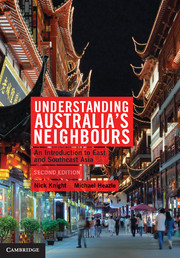Book contents
- Frontmatter
- Contents
- List of Maps
- Acronyms and abbreviations
- Acknowledgments
- Maps
- Introduction
- 1 The idea of ‘Asia’
- 2 Tradition and modernity in East and Southeast Asia
- 3 Tradition and modernity in East and Southeast Asia
- 4 Colonialism in East and Southeast Asia
- 5 Nationalism and revolution in East and Southeast Asia
- 6 Nations and nation-building in East and Southeast Asia
- 7 International politics and East and Southeast Asia
- 8 Economic growth in East and Southeast Asia
- 9 Democracy, human rights and development
- 10 Globalisation and East and Southeast Asia
- 11 China–Japan relations and US power in the twenty-first century
- 12 Australia in Asia, ‘Asia’ in Australia
- Bibliography
- Index
- References
2 - Tradition and modernity in East and Southeast Asia
The family
Published online by Cambridge University Press: 05 June 2012
- Frontmatter
- Contents
- List of Maps
- Acronyms and abbreviations
- Acknowledgments
- Maps
- Introduction
- 1 The idea of ‘Asia’
- 2 Tradition and modernity in East and Southeast Asia
- 3 Tradition and modernity in East and Southeast Asia
- 4 Colonialism in East and Southeast Asia
- 5 Nationalism and revolution in East and Southeast Asia
- 6 Nations and nation-building in East and Southeast Asia
- 7 International politics and East and Southeast Asia
- 8 Economic growth in East and Southeast Asia
- 9 Democracy, human rights and development
- 10 Globalisation and East and Southeast Asia
- 11 China–Japan relations and US power in the twenty-first century
- 12 Australia in Asia, ‘Asia’ in Australia
- Bibliography
- Index
- References
Summary
THE WORDS MOST FREQUENTLY encountered when studying Asia or listening to media reports on Asia are ‘tradition’ and ‘traditional’. One assumption is that we cannot understand Asia without knowing something about its traditions; another is that the influence of tradition in Asia remains particularly strong. It would seem from what we read in many scholarly and journalistic accounts that the influence of tradition is more powerful in Asian societies than it is in Western societies. There is often a sense that the ‘real’ Asia is the traditional Asia. The social and economic practices and institutions that have been imported from or heavily influenced by the West are not really ‘Asian’, regardless of how much they have been influenced by their Asian context. For example, an evening spent watching Beijing Opera would be seen by many as getting in touch with the ‘real’ China, the traditional China that existed before the West intervened and supposedly changed China. However, to go night-clubbing would not be seen as particularly ‘Chinese’. Dress is another obvious example. ‘Tradition’ is often equated with forms of dress that are non-Western. We might not regard the Japanese executive's business suit as ‘traditional’, but we would the dress of the samurai or geisha. There are similar examples from all of the societies of East and Southeast Asia. Western tourists (and increasing numbers of tourists from Asia itself) pay to see local people dressed in traditional costumes participating in traditional cultural activities, such as music, dance and theatre, believing this puts them in touch with the ‘real’ Asia, the Asia of ‘tradition’.
But what does the concept of ‘tradition’ mean and how important is it in understanding continuity and change in the societies of East and Southeast Asia? In this chapter and the next, we will respond to this question by examining two of the most important social institutions of a traditional society: the family and religion. We will investigate the nature of these institutions, and evaluate what changes have occurred to them as a result of Western influence and the process of modernisation. Comparisons will be made to the family and religion in Australia.
- Type
- Chapter
- Information
- Understanding Australia's NeighboursAn Introduction to East and Southeast Asia, pp. 23 - 41Publisher: Cambridge University PressPrint publication year: 2011



